Abstract
Laser-induced graphene (LIG) has gained considerable attention recently due to its unique properties and potential applications. In this study, we investigated using LIG in polyimide (PI) as a material for antenna applications. The LIG-−PI composite material was prepared by a facile picosecond laser (1064 nm) irradiation process, which resulted in a conductive graphene network within the PI matrix. Furthermore, LIG formation was confirmed by Raman spectroscopy and sheet resistance measurements. Finally, a patch antenna from LIG with 2.45 GHz microwaves was simulated, produced and tested. These findings suggest that LIG−PI composites have great potential for use in high-frequency electronic devices and can provide a new avenue for the development of flexible and wearable electronics.
1. Introduction
Laser-induced graphene (LIG) is a graphene material synthesized using lasers. Laser irradiation heats and transforms the material into a three-dimensional carbon structure during this process. Mainly being a one-step process, LIG formation gathers considerable attention due to its unique properties, such as mechanical flexibility, biocompatibility, and large electrical conductivity. These properties make this material for various wearable and flexible electronic device applications [1,2,3,4,5,6,7,8].
LIG can be produced, when the graphene oxide (GO) reduction process induces the removal of oxygen-containing groups from the GO matrix, the resulting conductive multilayer graphene matrix [9,10,11,12,13,14]. Furthermore, LIG formation can be performed on organic materials such as paper, wood, and food products and various polymers such as PDMS, polyimide, and PEI [5,6,15,16,17,18,19,20]. In addition, various groups have already applied the LIG process on various materials using different laser sources, such as pulsed 1064 nm, 532 nm, and 355 nm laser irradiation and CO2 lasers [20,21,22,23,24]. When pulsed lasers and shorter wavelengths are applied, the photochemical effect is more dominant during the LIG formation as photons, which possess higher energy and directly excite molecules of precursor materials. As a result, chemical bonds are broken, when high photon energy is absorbed. On the other hand, while 1064 nm of CO2 laser irradiation is applied, the photothermal effect, resulting in thermal energy production, is more prominent. In this case, laser irradiation causes lattice vibrations, increasing thermal energy and breaking chemical bonds [3,25].
One key aspect that affects manufacturing consistency is the laser parameters used during the synthesis process. Factors such as laser power, wavelength, duration, scanning speed, and scanning time [26] influence the quality and properties of the resulting LIG. Therefore, controlling these parameters precisely and consistently is crucial to obtaining uniform LIG samples while maintaining high production throughput [27].
Different polymers can yield varying results in terms of LIG quality and properties. Therefore, the choice of precursor materials plays a significant role in manufacturing consistency. Ensuring a consistent and reliable supply of high-quality precursor materials is essential for manufacturing consistency in LIG production.
Cao et al. [28] demonstrated that LIG could be stable and used in severe environmental conditions. In addition, different research groups demonstrated scalability options for LIG production [29,30,31,32]. Achieving large-scale, uniform, and high-quality LIG production remains a challenge that requires advancements in production techniques, equipment, and process optimization. The cost of laser equipment can be significant for industrial-scale production. On the other hand, the laser process offers flexibility for switching shapes and types of LIG-based electronic devices. Furthermore, choosing precursor materials for LIG production can impact the overall cost. Some precursors, such as polyimide, are more expensive than others. Recent results of LIG formation in paper or biomass products [6,26,32,33] may significantly decrease production costs and contribute to the circular economy.
It is worth noting that the research on laser-induced graphene is ongoing, and advancements are being made to improve manufacturing consistency [34]. As the understanding of the synthesis process deepens and standardized protocols are developed [27], it is expected that the manufacturing consistency of laser-induced graphene will continue to improve over time.
The application of LIG has already been demonstrated for sensors and IoT devices [8,35,36,37,38,39]. Some research groups have shown that LIG structures can be used as antennae [1,33,40]. LIG is lightweight and flexible. This flexibility allows for integrating LIG antennae into curved surfaces or wearable electronics, expanding their potential applications. The lightweight nature of LIG also minimizes the overall weight of devices, which is crucial for portable and lightweight electronics. This flexibility in LIG integration enables the development of innovative antenna designs and complex electronic systems. These benefits make LIG a promising material for advancing the performance and functionality of antennae and electronic devices. Therefore, this research presents our initial study of the LIG−PI application for a 2.45 GHz patch antenna working in the WiFi range.
2. Materials and Methods
2.1. Samples
Our experiments utilized Polyimide Kapton® films manufactured by DuPont (Wilmington, DE, USA) with a thickness of 127 μm.
2.2. LIG Formation
A picosecond solid-state laser Atlantic (Ekspla, Vilnius, Lithuania), operating at 1064 nm wavelength, was used for LIG formation experiments. The pulse duration was 10 ps, and the pulse repetition rate was 100 kHz. A SCANgine (ScanLab, Munich, Germany) galvanometer scanner with a telecentric F-theta objective of a 160 mm focal length was used for laser beam positioning. The beam scanning speed was 200 mm/s. The laser irradiation dose was changed by varying laser average power (4 and 5 W), defocusing and changing hatch distances between 20 μm and 30 μm. The sample was put under the focusing objective, and LIG patterns were formed by scanning the laser beam over the PI surface (Figure 1). In initial tests for selecting optimal parameters, the squares (10 × 10 mm) of LIG were formed on the PI surface. Raman measurements and sheet resistance measurements were performed on these samples. A patch antenna was produced using optimal laser process parameters (lowest sheet resistance to LIG).
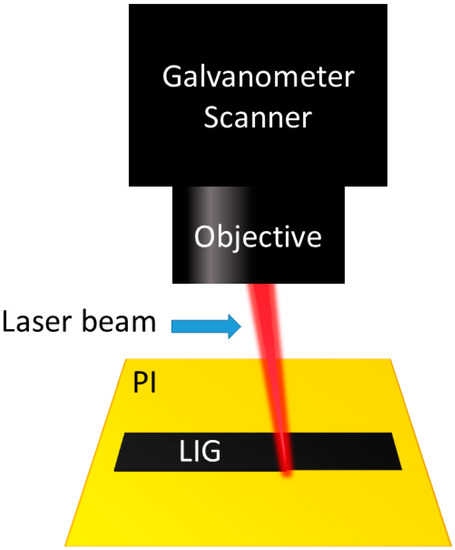
Figure 1.
Experimental setup of LIG formation.
2.3. Optical Microscopy
The optical microscope ECLIPSE LV100D (Nikon, Tokyo, Japan) was used to evaluate the thickness of the formed LIG layer.
2.4. Resistance Measurement
Sheet resistance measurements were performed using a source meter (Keithley 2602A, Keithley, Cleveland, OH, USA) with the measurement software (TSP® Express, Keithley, Cleveland, OH, USA). Measurements were performed using the 4-probe method [41]. Four co-linear electrical probes were identically spaced form a four-point probe. To operate, a DC current (I) was applied between the outer two probes, and the voltage drop between the inner two probes was then measured. The following equation can then be used to obtain the sheet resistance:
where Rs is the sheet resistance, ΔV is the change in voltage measured between the inner probes, and I is the current applied between the outer probes.
2.5. Raman Measurements
A Raman spectrometer/microscope inVia (Renishaw, Wotton-under-Edge, UK) was utilized for conducting Raman spectroscopic measurements. Equipped with a thermoelectrically cooled CCD detector at −70 °C, the spectrometer measured the spectra at a 532 nm laser irradiation dispersed by a 1800 grooves/mm grating. The laser power at the sample was 0.5 mW. The measurements were performed using a 50×/0.75 NA objective lens with a 100 s accumulation time, and the resulting spectral peaks were processed using OriginPro 8.5 software from Microlab (Northampton, MA, USA).
2.6. Antenna Modelling
CST Studio suite (Simulia, Johnston, RI, USA) software was employed to simulate LIG antennae.
2.7. Antenna Measurement
The following parameters were measured to evaluate the manufactured antennae: reflection coefficient, operating frequency, maximum gain, half-power beam width, and surface conductivity. Gain and directivity parameters were measured in an anechoic chamber. The measurement setup is explained in Figure 2. The antenna under investigation was placed on a rotation stand that could be rotated 360° by a stepping motor. The excitation port of an antenna was connected to a calibrated NRZP-Z24 (Rhode & Schwartz, Munich, Germany) power meter. The power meter was connected to a PC via a USB cable. A broadband horn antenna with known specifications was positioned 2 m away from the transmitting antenna (far-field). The horn antenna was connected to an E8257D (Agilent technologies, Santa Clara, CA, USA) programmable radio signal generator through a coaxial connection. The stand, the power meter, and the signal generator were all controlled by a LabVIEW (NI, Austin, TX, USA) program.
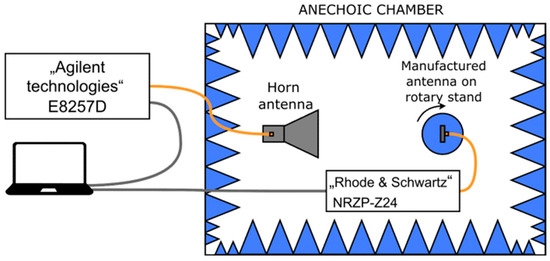
Figure 2.
Measurement setup in an anechoic chamber.
The frequency response was measured by keeping the power of the signal fed to the horn antenna constant (20 dBm) and changing the frequency from 2 GHz to 3 GHz in 0.01 GHz increments. The gain dependence on an angle was measured by setting a constant power (20 dBm), locking the frequency at 2.45 GHz and rotating the stand from 0° to 360° in 3° increments. Then, using Equation (2) derived from telegraph equations, the gain was calculated as follows:
where P is the measured power, R is the distance between antennae, PTR is the transmitted power, GTR is the transmitting antenna gain, and λ is the wavelength.
For more straightforward data interpretation, we normalized the gain measurements using the following equation:
where GMAX is the highest gain measured and G is the measured gain at angles or frequencies.
The antenna was also characterized by the frequency dependence of the reflection, which described the matching quality between the antenna and its excitation port (which was 50 Ω). For this purpose, a vector network analyzer was used.
3. Results and Discussion
3.1. Influence of the Laser Process Parameters on LIG Sheet Resistance and Raman Spectra
Our initial tests showed that varying laser process parameters could control sheet resistance. Therefore, we chose the 1064 nm picosecond laser irradiation, as it showed a relatively wide range of parameters, by using which high-quality LIG can be formed. Furthermore, Chyan et al. [26] showed that LIG formation multiple lasing—repeating irradiation—is crucial to achieving high-quality LIG materials. In other words, specific fluence and sufficient laser irradiation dose are required to form LIG.
During our laser tests, the laser scanning speed was kept at 200 mm/s, and the irradiation dose was varied by changing the average laser power (4 and 5 W), by varying the sample position according to the focal plane of the focusing objective—at the focus and 1 mm above and finally by the number of scanning times (2 and 3). The radiation dose assessment involved the multiplication of the laser fluence with the total number of pulses within the beam spot area.
Figure 3 shows the Raman spectrum of the LIG with the smallest resistance of 36.6 Ω/sq. This LIG structure was formed using a 148 J/cm2·N irradiation dose. The main peaks prominent for the graphene Raman spectra were visible. I(D)/I(G) was 0.61, and I(2D)/I(G) was 0.48. Further investigations of LIG antennae were performed using the laser process parameters from Figure 2 with the lowest sheet resistance.
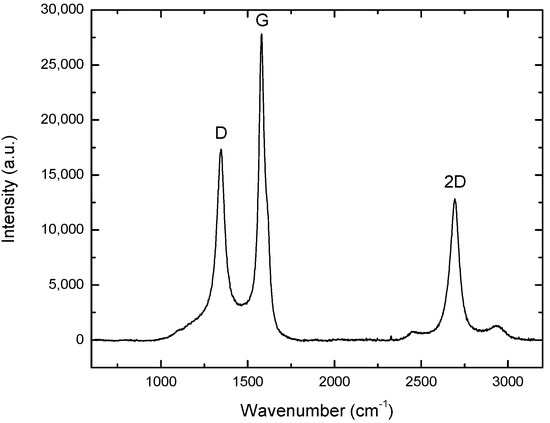
Figure 3.
Raman spectrum of LIG, formed using a 148 J/cm2·N irradiation dose and possessing the lowest sheet resistance of 36.6 Ω/sq.
Figure 4 shows the dependence of the sheet resistance from this accumulated irradiation dose. It is worth noticing that when the irradiation dose was in the range of 90–150 J/cm2·N, the sheet resistance was around 100 Ω/sq and significantly smaller compared to the ones measured at irradiation doses greater than 150–150 J/cm2·N. It is also worth noticing that all the lowest LIG sheet resistance values were achieved while LIG was processed with a defocused beam (1 mm above the focal plane of the focusing objective).
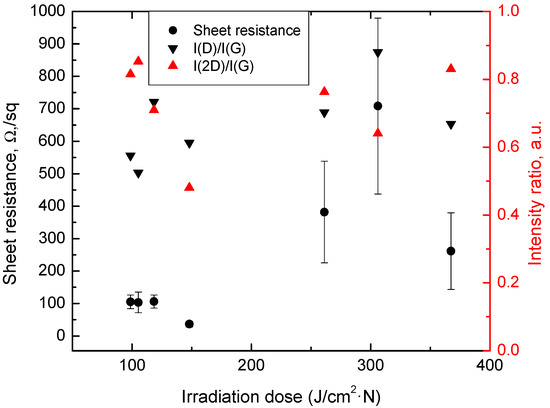
Figure 4.
Dependence of LIG sheet resistance and I(2D)/I(G) and I(2D)/I(G) intensity ratios of Raman spectra band intensities from the laser irradiation dose applied on PI.
The I(D)/I(G) ratio is the intensity ratio between the D and G peaks in graphene Raman spectra. The D peak represents defects or disorders in the graphene lattice, while the G peak corresponds to graphite-like lattice vibrations. Therefore, a higher I(D)/I(G) ratio indicates a higher degree of defects or disorder in the graphene structure.
On the other hand, the I(2D)/I(G) ratio represents the intensity ratio between the 2D peak and the G peak. The 2D peak is associated with the second-order Raman scattering and is a characteristic feature of graphene. The I(2D)/I(G) ratio determines the number of graphene layers. A higher I(2D)/I(G) ratio suggests an enhanced graphene quality: High-quality graphene with a well-ordered lattice structure typically displays a higher I(2D)/I(G)) ratio. Conversely, lower-quality graphene samples, such as those with a higher degree of disorder, defects, or impurities, tend to have lower I(2D)/I(G) ratios. These ratios provide insights into a sample’s quality, structural integrity, and number of graphene layers. Figure 4 presents the distributions of Raman spectra intensity ratios, i.e., I(D)/I(G) and I(2D)/I(G), and their values at different irradiation doses are plotted.
It is worth noticing that through the whole range of tested irradiation doses, we succeeded in achieving high-quality LIG formation, which was confirmed by the I(2D)/I(G) ratio higher than 0.5. The LIG samples formed with a low irradiation dose exhibited the highest I(2D)/I(G) values, indicating a high-quality graphene structure. Additionally, these samples demonstrated the lowest I(D)/I(G) values, suggesting a lower number of LIG structural defects. As mentioned before, this particular processing regime included a defocusing the laser beam. Therefore, with a higher beam diameter, the multiple lasing effect was more prominent, resulting in the formation of high-quality LIG; furthermore, the defocused laser beam induced the lowest resistance due to the lower laser beam intensity. Therefore, lower ablation rates and nonlinear effects such as multiple photon absorptions occur rarely during the process. The process thus generates more thermal energy, leading to graphene formation.
3.2. LIG Antenna Measurements
In order to demonstrate the possibility of using laser-induced graphene for microwave antenna application, we modelled a microwave patch antenna shown in Figure 5. The antenna was made of an FR-4 substrate (tanδ = 0.03) with a thickness of 1.45 mm and ε = 4.2. One side of the FR4 substrate was completely covered with a thin copper layer and formed the ground plane of the antenna. The dimensions of the FR4 substrate were FR4x = 110 mm and FR4y = 54 mm. The polyimide was deposited on the FR-4 substrate using a commercially available adhesive designed for bonding polyimide films to various substrates. The adhesive was applied uniformly on the backside of the polyimide film, ensuring complete coverage. The use of the adhesive facilitated a strong and reliable bond between the polyimide film and the FR-4 substrate, ensuring mechanical stability and secure attachment. After successfully attaching the polyimide film to the substrate, we proceeded with the laser-induced graphene (LIG) formation on the polyimide film. The thickness of the polyimide was approximately 130 μm), and the LIG layer’s thickness was around 10 μm (evaluated using an optical microscope). The dimensions of the LIG patch were GRx = 20 mm and GRy = 29 mm. The LIG patch was placed in the middle of the FR4 substrate. During the antenna modelling, the best patch size and the place of the SMA connector were found to have the smallest S11 and the highest antenna gain.
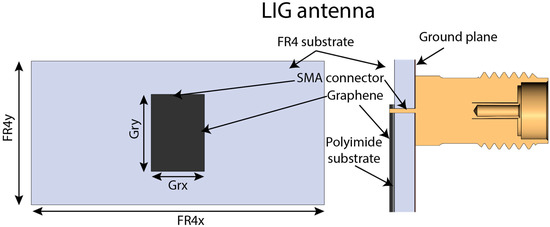
Figure 5.
Proposed patch antenna with LIG graphene. Left—patch antenna; right—antenna cross-section.
Reflection and normalized directivity measurements were used to characterize a graphene antenna, which are shown in Figure 6. Looking at the measured reflection dependence on frequency, the antenna appeared to have a reasonably broad operating frequency band. The reflection coefficient was below −10 dB from 2.1 GHz and continued to decrease to −13 dB at 5 GHz. This did not match the typical patch antenna behavior. LIG’s low conductivity might cause a mismatch compared to traditionally used copper. This phenomenon was investigated by changing the patch sheet resistance in the antenna model using CST Studio suite for antenna simulation (Figure 6a). Simulation results showed that when the LIG sheet resistance was low, the antenna acted like a regular patch antenna and had a reflection minimum at the intended frequency (2.45 GHz). When the sheet resistance of the LIG layer increased, the resonance disappeared and the reflections in the whole frequency range decreased. This could be explained due to internal losses in the LIG layer. The simulation of the results coincided best with the measured S11, when the sheet resistance was around 30–40 Ω/sq. A similar sheet resistance was obtained by performing four-probe measurements. Considering the high internal losses in the LIG layer, it was required to develop a higher-conductivity LIG layer to achieve better impedance matching. Enhancing the conductivity of the LIG material is an area for future research. Directivity measurements showed that the radiation pattern resembled a traditional patch antenna. The antenna beamwidths were 63° in the vertical position and 80° in the horizontal position.
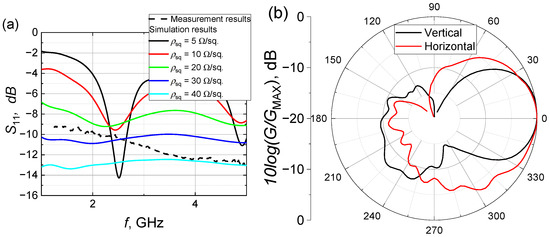
Figure 6.
Antenna simulation and measurement results: (a) reflection coefficient S11. Solid lines represent simulation results, and the dashed line represents measurement results; (b) antenna directivity.
Table 1 presents simulation results for the patch antennae with both laser-induced graphene (LIG) and copper patches at 2.45 GHz. Comparing the results, it is evident that the LIG patch antennae exhibited lower performance in terms of S11 and directivity compared to the copper patch antenna with a sheet resistance of 0.01 Ω/sq. However, the LIG patch antennae still demonstrate a remarkable potential. As the sheet resistance of the LIG patch decreased, there were noticeable improvements in S11, directivity, beamwidth, and efficiency. The results indicate that if the sheet resistance of the LIG patch can be further reduced, it has the potential to compete with the copper patch antenna in terms of performance metrics. This suggests a promising future for LIG-based patch antennae, with the possibility of achieving higher efficiency and comparable or even better overall performance.

Table 1.
Comparison of performance parameters of LIG and copper patch antennae.
Table 2 compares the results of our proposed laser-induced graphene (LIG) patch antenna with the results from other sources in the literature. It highlights the advantages of our proposed antenna design. Regarding the reflection coefficient, our LIG patch antenna demonstrated a favorable performance with a value of −13 dB, indicating lower signal reflection compared to the other antenna types in the table, suggesting improved impedance matching and reduced signal loss. Additionally, our antenna exhibited a sheet resistance ranging from 30 to 40 Ω/sq, which was relatively low compared to some other antennae [42]. This lower sheet resistance contributed to enhanced conductivity and improved signal transmission efficiency.

Table 2.
Comparison of performance parameters of reported graphene-based antennae.
4. Conclusions
Successful LIG formation was performed with a wide range of laser irradiation doses and was confirmed by Raman spectroscopy—I(2D)/I(G) was higher than 0.5. The sheet resistance was smallest at irradiation doses from 98 to 148 J/cm2·N, when the PI sample was irradiated at the position 1 mm above the focal plane of the focusing objective. The minimum sheet resistance of LIG was 36.6 Ω/sq. Using optimal process parameters, a patch antenna at 2.45 GHz (WiFi) was produced and investigated.
The results of the patch antenna with an LIG layer show promising results as one of the alternative methods as green and sustainable solutions to manufacturing removable and flexible antennae. However, additional investigations still need to be performed to reduce the LIG layer sheet resistance and increase the antenna efficiency. For this purpose, further optimization of the LIG process by tuning laser process parameters and investigating other substrates will be performed.
Author Contributions
Conceptualization, P.R., K.R. and R.T.; methodology, A.S., J.Ž., P.R. and R.T.; software, P.R.; validation, A.S., J.Ž., P.R., K.R. and R.T.; formal analysis, A.S. and J.Ž.; investigation, P.R., K.R. and R.T.; writing—original draft preparation, P.R. and R.T.; writing—review and editing, R.T.; visualization, P.R. and R.T.; supervision, R.T.; project administration, K.R. and R.T. All authors have read and agreed to the published version of the manuscript.
Funding
This project has received funding from European Regional Development Fund (project BEGAMA No 01.2.2-LMT-K-718-03-0038) under grant agreement with the Research Council of Lithuania (LMTLT).
Data Availability Statement
The data supporting this study’s findings are available from the corresponding author upon reasonable request.
Acknowledgments
Authors are grateful to Martynas Talaikis for accessing Raman spectroscopy at the Laboratory of Spectroelectrochemistry of the Department of Organic Chemistry (FTMC, Lithuania).
Conflicts of Interest
The authors declare no conflict of interest.
References
- Wanjari, V.P.; Reddy, A.S.; Duttagupta, S.P.; Singh, S.P. Laser-Induced Graphene-Based Electrochemical Biosensors for Environmental Applications: A Perspective. Environ. Sci. Pollut. Res. 2023, 30, 42643–42657. [Google Scholar] [CrossRef] [PubMed]
- Liu, H.; Chen, Y. Laser-Induced Graphene Film and Its Applications in Flexible Electronics. Appl. Sci. 2022, 12, 1233. [Google Scholar] [CrossRef]
- Vivaldi, F.M.; Dallinger, A.; Bonini, A.; Poma, N.; Sembranti, L.; Biagini, D.; Salvo, P.; Greco, F.; Di Francesco, F. Three-Dimensional (3D) Laser-Induced Graphene: Structure, Properties, and Application to Chemical Sensing. ACS Appl. Mater. Interfaces 2021, 13, 30245–30260. [Google Scholar] [CrossRef] [PubMed]
- Barber, R.; Cameron, S.; Devine, A.; McCombe, A.; Kirsty Pourshahidi, L.; Cundell, J.; Roy, S.; Mathur, A.; Casimero, C.; Papakonstantinou, P.; et al. Laser Induced Graphene Sensors for Assessing PH: Application to Wound Management. Electrochem. Commun. 2021, 123, 106914. [Google Scholar] [CrossRef]
- Peng, Z.; Lin, J.; Ye, R.; Samuel, E.L.G.; Tour, J.M. Flexible and Stackable Laser-Induced Graphene Supercapacitors. ACS Appl. Mater. Interfaces 2015, 7, 3414–3419. [Google Scholar] [CrossRef]
- Kulyk, B.; Silva, B.F.R.; Carvalho, A.F.; Silvestre, S.; Fernandes, A.J.S.; Martins, R.; Fortunato, E.; Costa, F.M. Laser-Induced Graphene from Paper for Mechanical Sensing. ACS Appl. Mater. Interfaces 2021, 13, 10210–10221. [Google Scholar] [CrossRef] [PubMed]
- Stanford, M.G.; Zhang, C.; Fowlkes, J.D.; Hoffman, A.; Ivanov, I.N.; Rack, P.D.; Tour, J.M. High-Resolution Laser-Induced Graphene. Flexible Electronics beyond the Visible Limit. ACS Appl. Mater. Interfaces 2020, 12, 10902–10907. [Google Scholar] [CrossRef]
- Žutautas, V.; Trusovas, R.; Sartanavičius, A.; Ratautas, K.; Selskis, A.; Pauliukaite, R. A Sensor for Electrochemical PH Monitoring Based on Laser-Induced Graphene Modified with Polyfolate. Chemosensors 2023, 11, 329. [Google Scholar] [CrossRef]
- Trusovas, R.; Ratautas, K.; Račiukaitis, G.; Barkauskas, J.; Stankevičiene, I.; Niaura, G.; Mažeikiene, R. Reduction of Graphite Oxide to Graphene with Laser Irradiation. Carbon N. Y. 2013, 52, 574–582. [Google Scholar] [CrossRef]
- Wei, Z.; Wang, D.; Kim, S.; Kim, S.Y.; Hu, Y.; Yakes, M.K.; Laracuente, A.R.; Dai, Z.; Marder, S.R.; Berger, C.; et al. Nanoscale Tunable Reduction of Graphene Oxide for Graphene Electronics. Science 2010, 328, 1373–1376. [Google Scholar] [CrossRef]
- Kumar, P.; Subrahmanyam, K.S.; Rao, C.N.R. Graphene Produced by Radiation-Induced Reduction of Graphene Oxide. Int. J. Nanosci. 2011, 10, 559–566. [Google Scholar] [CrossRef]
- Sokolov, D.A.; Shepperd, K.R.; Orlando, T.M. Formation of Graphene Features from Direct Laser-Induced Reduction of Graphite Oxide. J. Phys. Chem. Lett. 2010, 1, 2633–2636. [Google Scholar] [CrossRef]
- Sokolov, D.A.; Rouleau, C.M.; Geohegan, D.B.; Orlando, T.M. Excimer Laser Reduction and Patterning of Graphite Oxide. Carbon N. Y. 2013, 53, 81–89. [Google Scholar] [CrossRef]
- Trusovas, R.; Račiukaitis, G.; Barkauskas, J.; Mažeikienė, R. Laser Induced Graphite Oxide/Graphene Transformation. J. Laser Micro Nanoeng. 2012, 7, 49. [Google Scholar] [CrossRef]
- Ye, R.; James, D.K.; Tour, J.M. Laser-Induced Graphene. Acc. Chem. Res. 2018, 51, 1609–1620. [Google Scholar] [CrossRef]
- Luong, D.X.; Yang, K.; Yoon, J.; Singh, S.P.; Wang, T.; Arnusch, C.J.; Tour, J.M. Laser-Induced Graphene Composites as Multifunctional Surfaces. ACS Nano 2019, 13, 2579–2586. [Google Scholar] [CrossRef] [PubMed]
- Lin, J.; Peng, Z.; Liu, Y.; Ruiz-Zepeda, F.; Ye, R.; Samuel, E.L.G.; Yacaman, M.J.; Yakobson, B.I.; Tour, J.M. Laser-Induced Porous Graphene Films from Commercial Polymers. Nat. Commun. 2014, 5, 5714. [Google Scholar] [CrossRef] [PubMed]
- Lopes, D.V.; Santos, N.F.; Moura, J.P.; Fernandes, A.J.S.; Costa, F.M.; Kovalevsky, A.V. Design of Laser-Induced Graphene Electrodes for Water Splitting. Int. J. Hydrogen Energy 2023, 48, 4158–4172. [Google Scholar] [CrossRef]
- Trusovas, R.; Ratautas, K.; Račiukaitis, G.; Niaura, G. Graphene Layer Formation in Pinewood by Nanosecond and Picosecond Laser Irradiation. Appl. Surf. Sci. 2019, 471, 154–161. [Google Scholar] [CrossRef]
- Fiodorov, V.; Ratautas, K.; Mockus, Z.; Trusovas, R.; Mikoliūnaitė, L.; Račiukaitis, G. Laser-Assisted Selective Fabrication of Copper Traces on Polymers by Electroplating. Polymers 2022, 14, 781. [Google Scholar] [CrossRef]
- Ruan, X.; Wang, R.; Luo, J.; Yao, Y.; Liu, T. Experimental and Modeling Study of CO2 Laser Writing Induced Polyimide Carbonization Process. Mater. Des. 2018, 160, 1168–1177. [Google Scholar] [CrossRef]
- Ma, L.; Wang, Y.; Wang, Y.; Wang, C.; Gao, X. Graphene Induced Carbonization of Polyimide Films to Prepared Flexible Carbon Films with Improving-Thermal Conductivity. Ceram. Int. 2020, 46, 3332–3338. [Google Scholar] [CrossRef]
- In, J.B.; Hsia, B.; Yoo, J.H.; Hyun, S.; Carraro, C.; Maboudian, R.; Grigoropoulos, C.P. Facile Fabrication of Flexible All Solid-State Micro-Supercapacitor by Direct Laser Writing of Porous Carbon in Polyimide. Carbon N. Y. 2015, 83, 144–151. [Google Scholar] [CrossRef]
- Wang, S.; Yu, Y.; Li, R.; Feng, G.; Wu, Z.; Compagnini, G.; Gulino, A.; Feng, Z.; Hu, A. High-Performance Stacked in-Plane Supercapacitors and Supercapacitor Array Fabricated by Femtosecond Laser 3D Direct Writing on Polyimide Sheets. Electrochim. Acta 2017, 241, 153–161. [Google Scholar] [CrossRef]
- Wang, L.; Wang, Z.; Bakhtiyari, A.N.; Zheng, H. A Comparative Study of Laser-Induced Graphene by CO2 Infrared Laser and 355 nm Ultraviolet (UV) Laser. Micromachines 2020, 11, 1094. [Google Scholar] [CrossRef] [PubMed]
- Chyan, Y.; Ye, R.; Li, Y.; Singh, S.P.; Arnusch, C.J.; Tour, J.M. Laser-Induced Graphene by Multiple Lasing: Toward Electronics on Cloth, Paper, and Food. ACS Nano 2018, 12, 2176–2183. [Google Scholar] [CrossRef]
- Murray, R.; Burke, M.; Iacopino, D.; Quinn, A.J. Design of Experiments and Optimization of Laser-Induced Graphene. ACS Omega 2021, 6, 16736–16743. [Google Scholar] [CrossRef]
- Cao, L.; Zhu, S.; Pan, B.; Dai, X.; Zhao, W.; Liu, Y.; Xie, W.; Kuang, Y.; Liu, X. Stable and Durable Laser-Induced Graphene Patterns Embedded in Polymer Substrates. Carbon N. Y. 2020, 163, 85–94. [Google Scholar] [CrossRef]
- Gupta, A.; Sharma, C.P.; Arnusch, C.J. Simple Scalable Fabrication of Laser-Induced Graphene Composite Membranes for Water Treatment. ACS ES&T Water 2021, 1, 881–887. [Google Scholar] [CrossRef]
- Lee, Y.A.; Jang, K.; Yoon, H. A Facile and Scalable Fabrication of High-Performance Flexible Laser-Induced-Graphene Micro-Supercapacitors Using Ultrafast Pulse Laser. ECS Meet. Abstr. 2022, MA2022-02, 2562. [Google Scholar] [CrossRef]
- Liu, F.; Gao, Y.; Wang, G.; Wang, D.; Wang, Y.; He, M.; Ding, X.; Duan, H.; Luo, S. Laser-Induced Graphene Enabled Additive Manufacturing of Multifunctional 3D Architectures with Freeform Structures. Adv. Sci. 2023, 10, 2204990. [Google Scholar] [CrossRef]
- Wang, Y.; Wang, Y.; Zhang, P.; Liu, F.; Luo, S. Laser-Induced Freestanding Graphene Papers: A New Route of Scalable Fabrication with Tunable Morphologies and Properties for Multifunctional Devices and Structures. Small 2018, 14, 1802350. [Google Scholar] [CrossRef] [PubMed]
- Ahmad, M.; Cantarella, G.; Angeli, M.A.C.; Madagalam, M.; Ebner, C.; Ciocca, M.; Riaz, R.; Ibba, P.; Petrelli, M.; Merino, I.; et al. 2.4 GHz Microstrip Patch Antenna Fabricated by Means of Laser Induced Graphitization of a Cellulose-Based Paper Substrate. In Proceedings of the 2021 IEEE International Flexible Electronics Technology Conference (IFETC), Columbus, OH, USA, 8–11 August 2021; pp. 44–46. [Google Scholar]
- Le, T.-S.D.; Phan, H.-P.; Kwon, S.; Park, S.; Jung, Y.; Min, J.; Chun, B.J.; Yoon, H.; Ko, S.H.; Kim, S.-W.; et al. Recent Advances in Laser-Induced Graphene: Mechanism, Fabrication, Properties, and Applications in Flexible Electronics. Adv. Funct. Mater. 2022, 32, 2205158. [Google Scholar] [CrossRef]
- Mostaccio, A.; Antonelli, G.; Bragaglia, M.; Martinelli, E.; Marrocco, G. Comparative Evaluation of Laser Induced Graphene (LIG) Traces on Polyimide under Soft and Hard Stress for IoT Applications. IEEE J. Flex. Electron. 2023, 1. [Google Scholar] [CrossRef]
- Liao, J.; Zhang, X.; Sun, Z.; Chen, H.; Fu, J.; Si, H.; Ge, C.; Lin, S. Laser-Induced Graphene-Based Wearable Epidermal Ion-Selective Sensors for Noninvasive Multiplexed Sweat Analysis. Biosensors 2022, 12, 397. [Google Scholar] [CrossRef]
- Wan, Z.; Nguyen, N.-T.; Gao, Y.; Li, Q. Laser Induced Graphene for Biosensors. Sustain. Mater. Technol. 2020, 25, e00205. [Google Scholar] [CrossRef]
- Zhu, J.; Guo, X.; Wang, H.; Song, W. Cost-Effective Fabrication and High-Frequency Response of Non-Ideal RC Application Based on 3D Porous Laser-Induced Graphene. J. Mater. Sci. 2018, 53, 12413–12420. [Google Scholar] [CrossRef]
- Sindhu, B.; Kothuru, A.; Sahatiya, P.; Goel, S.; Nandi, S. Laser-Induced Graphene Printed Wearable Flexible Antenna-Based Strain Sensor for Wireless Human Motion Monitoring. IEEE Trans Electron. Devices 2021, 68, 3189–3194. [Google Scholar] [CrossRef]
- Abdul-Aziz, M.R.R.; Mohassieb, S.A.; Eltresy, N.A.; Yousef, M.M.K.; Anis, B.; Abdellatif, S.O.; Khalil, A.S.G. Enhancing the Performance of Polygon Monopole Antenna Using Graphene/TMDCs Heterostructures. IEEE Trans. Nanotechnol. 2020, 19, 269–273. [Google Scholar] [CrossRef]
- Smits, F.M. Measurement of Sheet Resistivities with the Four-Point Probe. Bell Syst. Tech. J. 1958, 37, 711–718. [Google Scholar] [CrossRef]
- Rivadeneyra, A.; Salmeron, J.F.; Rodriguez, N.; Morales, D.P.; Colella, R.; Chietera, F.P.; Catarinucci, L. Laser-Fabricated Antennas for RFID Applications. In Proceedings of the 2020 50th European Microwave Conference (EuMC), Utrecht, The Netherlands, 12–14 January 2021; pp. 812–815. [Google Scholar]
- Inum, R.; Rana, M.M.; Shushama, K.N. Performance Analysis of Graphene Based Nano Dipole Antenna on Stacked Substrate. In Proceedings of the 2016 2nd International Conference on Electrical, Computer & Telecommunication Engineering (ICECTE), Rajshahi, Bangladesh, 8–10 December 2016; pp. 1–4. [Google Scholar]
Disclaimer/Publisher’s Note: The statements, opinions and data contained in all publications are solely those of the individual author(s) and contributor(s) and not of MDPI and/or the editor(s). MDPI and/or the editor(s) disclaim responsibility for any injury to people or property resulting from any ideas, methods, instructions or products referred to in the content. |
© 2023 by the authors. Licensee MDPI, Basel, Switzerland. This article is an open access article distributed under the terms and conditions of the Creative Commons Attribution (CC BY) license (https://creativecommons.org/licenses/by/4.0/).